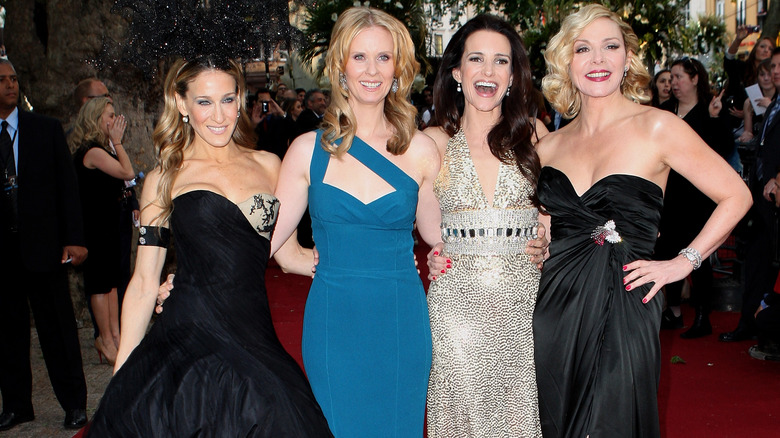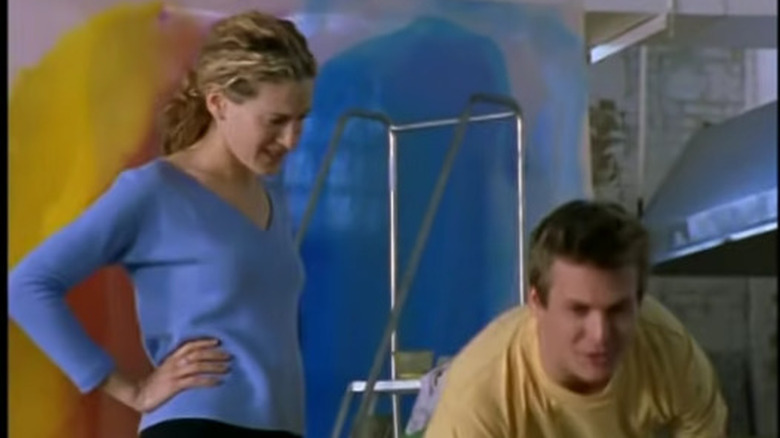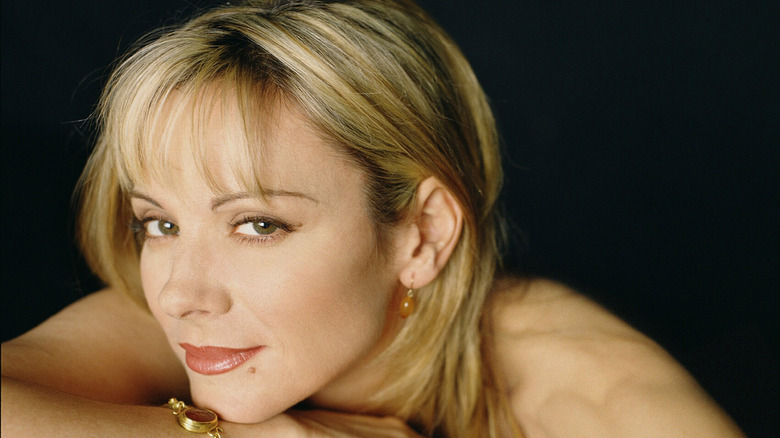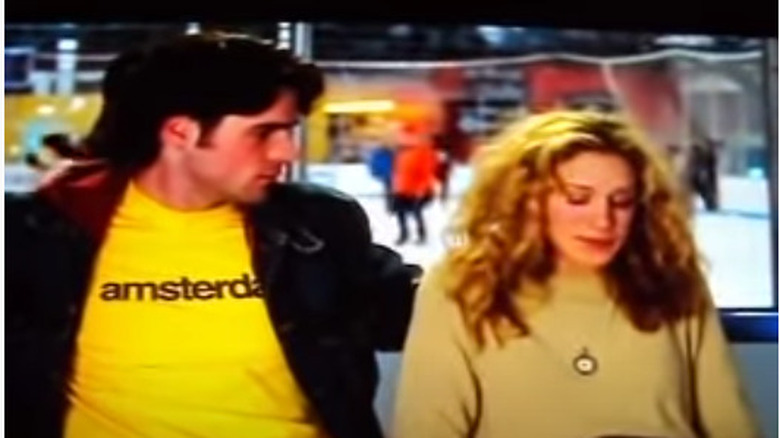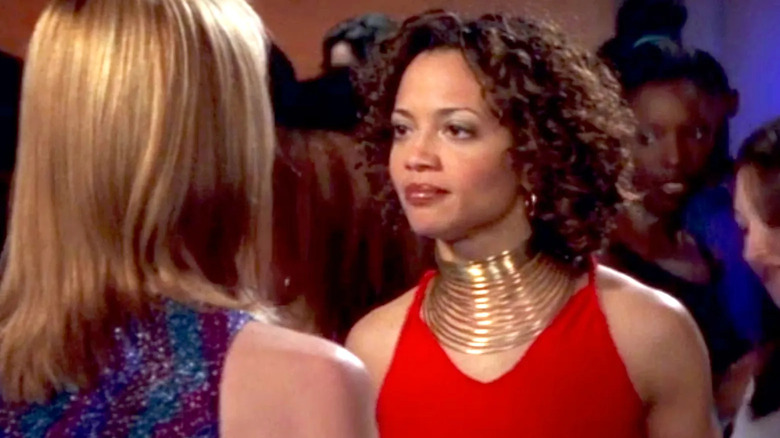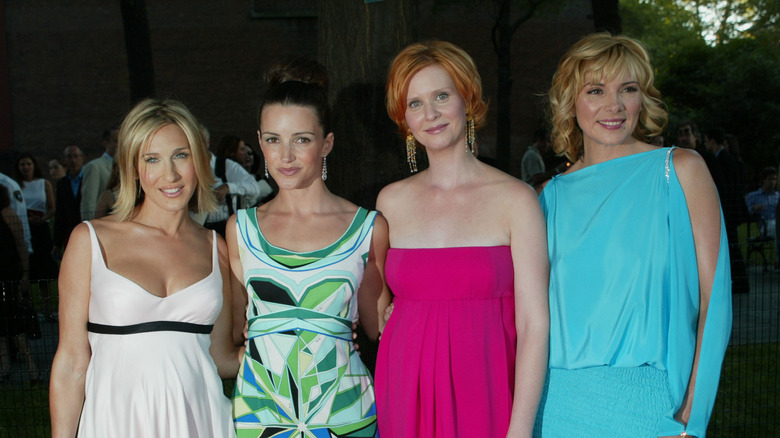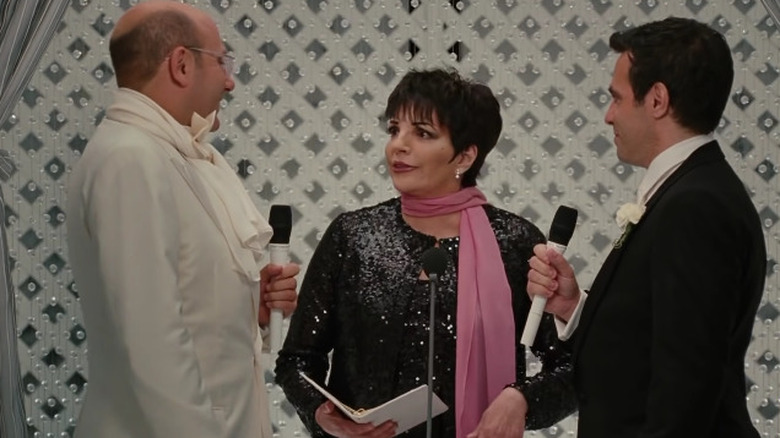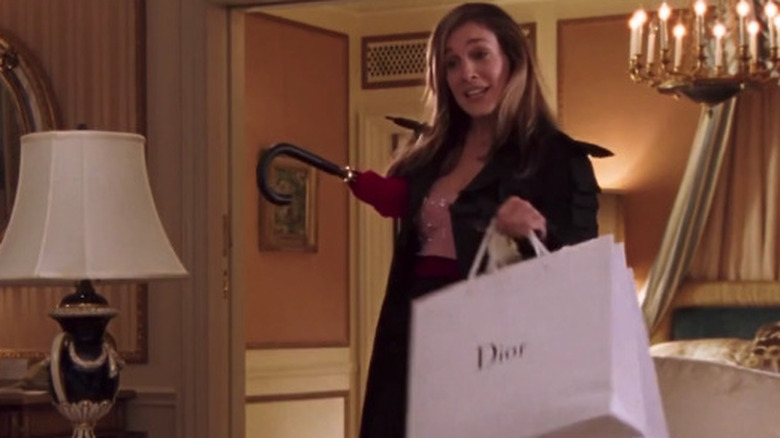Moments From Sex And The City That Didn't Age Well
In the summer of 1998, Carrie, Samantha, Charlotte, and Miranda strolled into our lives with six-inch Manolo Blahniks, couture from the runway, and the latest Birken bags swaying from their arms. We'd often find them at the latest dining hotspot, catching each other up on the city dalliances of the evening before, or at department stores swiping charges and swapping chatter. As viewers, we were instantly drawn to the glamorous lives these ladies led. One could easily deem themselves the fifth girl of the group, as we all collectively went through the heartbreaks, hang-ups, and hundreds of cosmos together every Sunday for six seasons.
Loosely based on author Candace Bushnell's book of the same title, HBO's "Sex and the City" garnered an array of accolades, including multiple Emmy and Golden Globe wins. Following the series came two feature-length films and one spinoff. It's fair to say that over 20 years later, we still can't get enough of "Sex."
As we periodically indulge in rewatches, it's evident that the series was created during a vastly different cultural landscape. Moments that once garnered a passing chuckle now sting in modern times with the progression of social evolution. As we look back on the beloved series that reset the television landscape in an otherwise male-dominated industry, we "couldn't help but wonder" ...which "Sex and the City" moments are now outdated?
Videotaping without consent
In the second episode of the series, Carrie's womanizer friend Barkley declares models as his preference. While this isn't entirely problematic in itself, as we're all entitled to our tastes, he goes on to proudly declare to Carrie that models are "easier," before showing off his collection of tapes in which he'd filmed intimate moments with these women, without their consent. Carrie watches the multiple monitors in puzzlement as Barkley stares admiringly at his "artistic work."
Though Carrie finds this hobby strange, she casually brushes it off as if it is just some peculiar personality trait that needs no further investigation or questioning. "There are some passing instances that didn't register with most of us at the time," stated Jennifer Keishin Armstrong, author of "Sex and the City and Us." In regards to how the series holds up in the #MeToo age, she shared that some of the sexual freedoms portrayed on the show are now anachronistic, per Vanity Fair.
Passing judgement on Samantha's way of life
Samantha Jones walked and talked confidence, independence, and sexual liberation. She often proudly shared recounts of her sexual adventures with an array of partners, which were often casual flings or one-night stands. In retrospect, Samantha's attitude toward sex was ahead of its time, and is one of the examples of how this show broke the mold by portraying strong, progressive women touting their sexual lives just as casually and outwardly as men do. It was Samantha's view that men only had one purpose — to serve — and when that was fulfilled, she had no further use for them.
Unfortunately for Samantha, her closest gals were her harshest critics. In one episode, this causes tension between Samantha and Carrie, as Carrie accidentally walks in on Samantha, uh, engaging in some down-south stamp licking with her postman. Carrie — a sex columnist with a supposedly open mind — feels embarrassed and questions Samantha's actions. As Samantha rightfully refuses to apologize, we are graced with the now-timeless line: "I will wear whatever and blow whomever I want as long as I can breathe and kneel!" (via YouTube).
Narrow views on bisexuality
In a Season 3 episode, Carrie starts dating a guy. Things seem to be going well, so he decides to confide in her that he is actually bisexual. This seems to catch Carrie off-guard and propels her to question further pursuing the relationship. When Carrie shares this personal information with the girls over brunch, she proclaims that she doesn't even think bisexuality is real, but rather a "layover on the way to gay town." Charlotte chimes in, stating that people should "pick a side and stay there," while Miranda labels bisexuality as "greedy" and problematic.
Actress Sarah Jessica Parker would later share that the show would be "very different" if it were made today. "There was no substantial conversation about the LGBTQ community," she stated, adding that the lack of representation from the show and characters was simply a product of their time, via LogoTV. The current spinoff "And Just Like That" includes an array of LGBTQ representation.
Stereotype tropes
In a Season 3 episode, Samantha begins dating a Black music industry mogul named Chivon. Despite the fact that Samantha normally wouldn't entertain the thought of an actual relationship, she finds herself really liking Chivon, as their chemistry and compatibility build throughout the episode. This leads Chivon to take the next step in their relationship: having Samantha meet his sister, Adeena.
Adeena, played by Jamaican-American actress Sundra Oakley, is polite and friendly with Samantha. Though when she realizes Samantha may not be going away anytime soon, her attitude begins to unravel as she starts vocalizing her distaste for her brother dating a white woman. Tensions between Samantha and Adeena heat up, and Adeena eventually loses her cool completely, playing into the "angry Black woman" trope.
Oakley would later go on to reflect on the scene to Vanity Fair. "When I was looking at it through the lens of 20-years-ago Sundra, I was happy to have this job and work on this fabulous show, but even a few years later ... it's like, oh man, why did it have to be that way? Why couldn't it have been a different story?"
Lack of diversity
All main and supporting characters in "Sex and the City" were white, which is a poor reflection of the diversity that New York City actually offers. Moreover, there are moments when racial diversity is used in stereotype and not much else, such as Carrie groaning over her gold engagement ring, claiming she'd really only wear "ghetto gold."
Whenever the show attempted to move in the correct direction of diversity, it only perpetuated tropes. In the first film, Academy Award winner Jennifer Hudson plays Louise, a Black woman in the subservient role of assistant to her white boss, whom she practically worships, Glamour Magazine notes. Speaking with "Today," actress Cynthia Nixon recognizes the diversity problem. "That was something that I was aware of at the time and said at the time and I think a number of us said it," she shared, adding that if the show were filmed today, it would be "very different."
Poor representation of gay men
Stanford Blatch was Carrie's gay best friend. Fashionable, flamboyant, and feminine, he was always around to entertain Carrie with the latest gossip on men and fashion. In retrospect, Stanford — though a loveable fan favorite — provided little to no substance, as his character fit into the stereotypical gay male trope. In the end, Stanford was nothing more than just a gay accessory Carrie would casually entertain, like a purse that went well with one of her outfits.
If this wasn't evident in the series, it certainly was in the second film. Stanford and Charlotte's gay pal Anthony tied the knot in the most over-the-top fanfare of a ceremony, complete with a gay male chorus crooning Broadway show tunes, swans, and Liza Minelli performing her own rendition of "Single Ladies" by Beyonce. "Just when you thought everyone was too old to get married, here come the gays!" Carrie exclaimed.
"It's the clichéd, condescending hetero fantasy, the one in which you introduce the only two gay men you know, and magically, the sparks fly," notes Thomas Rogers of Salon.
Carrie's unrealistic lifestyle
Carrie lived in a spacious apartment in a good block in Manhattan. She obsessively shopped and dined out in some of the hottest spots in the city. As her only source of income was writing a column that ran once a week, there was a misrepresentation of living comfortably in the city. She has admitted to buying Vogue instead of food because "it fed her more," and proudly proclaimed that she likes her money right where she can see it, "hanging in a closet."
In a rare episode in Season 4 where Carrie's unrealistic spending habits are actually acknowledged, we learned that she had close to nothing in her bank account, no stocks or bonds, and no chance for a bank loan. Her salary-to-spending ratio had been one of the bigger topics of debate, with budgeting experts weighing in, stating that it would actually take her 172 years to realistically afford her apartment.
Body shaming
There are several moments in the series where negative remarks are made about bodies. Regarding models in an early episode, the girls referred to models as "giraffes with big breasts," with Miranda adding that she'd like to feed them some lard. In another moment later in the series, Miranda was ashamed of the weight she gained while pregnant with Brady. To get back on track, she joined Weight Watchers and met a group of other self-loathing individuals who had a difficult time accepting their bodies at any weight.
The most glaring example of body shaming is undoubtedly during the first film, when Samantha greeted the girls after flying in from Los Angeles. Carrie, Miranda, and Charlotte collectively gasped in horror as they noticed that her stomach wasn't as flat as they were used to seeing. "Mother of God, what's with the gut?" Anthony exclaimed, while Carrie lamented, "How could you not realize it?" Fans weighed in on this problematic scene, with one stating "I would be so happy if that were my stomach."
Cultural stereotypes while traveling
In the first "Sex and the City" film, the girls go on Carrie's jilted honeymoon together. Staying at a five-star resort in Mexico, the girls are treated to fine dining, mariachi bands, and margaritas. However, Charlotte absolutely refuses to take place in any of the resort offerings, particularly the food and water. Instead, she fills herself with pudding from Poughkeepsie. "It's a five-star resort!" claims Miranda. "It's Mexico!" Charlotte replies under her breath, reinforcing the culturally insensitive notion that food and water from Mexico are dirty.
Meanwhile, in the second film, after the women spend much of their time in Abu Dhabi grasping for home comforts, the local women all but strip themselves of their niqābs to reveal the latest New York spring collection. This plays into the trope that American tourists can only handle so much foreign culture, and therefore locals must adjust their behavior for the sake of the tourists' comfort. The girls then sigh in relief as they're finally comforted with familiar sights, and soon after dress themselves in the niqābs to escape the bargainers of the souks and make it to their first-class flight on time. Vice further outlines the culturally insensitive moments of the second film.
Romanticizing toxic relationships
We saved the Big for last. John James Preston, aka Big, is Carrie's continuous love interest throughout the entire "Sex and the City" series. Ever-elusive, he waltzes in and out of her life as he pleases, seemingly destroying all efforts Carrie makes to lead a life of independence and empowerment.
At the height of their toxicity, both parties were individually in otherwise healthy and loving relationships, yet still couldn't muster the self-respect to walk away from one another. As viewers, we were encouraged to root for this unhealthy relationship, and oftentimes we did, even though we all knew he wasn't good for her. Carrie herself knew this, as she once exclaimed, "Why is it so hard for you to factor me into your life in any real way?"
Regarding the impression this may leave on viewers, dating and relationship expert Sarah Louise Ryan shared with Vogue, "We've become so used to seeing unhealthy relationships on screen that we consider them normal — even aspirational."
